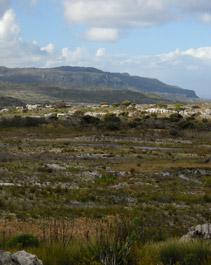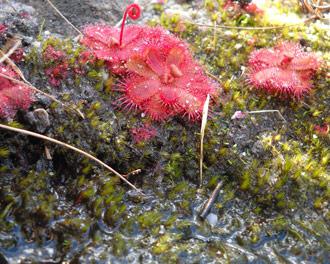Drosera trinervia
Drosera trinervia Spreng.
Family: Droseraceae
Common names: small sundew (Eng.); klein sondouw (Afr.)
Introduction
This opportunistic little Drosera is one of the most common carnivorous plant species in South Africa and can be found growing amongst fynbos during winter and spring.

Description
Description
Drosera trinervia is a perennial carnivorous plant and can be recognised by its small basal rosettes covered with reddish, sticky, glandular hairs. The palnts are only 50 - 100 mm high and have one or two long, slightly swollen roots. The wedge-shaped laminas (leaf blades) have slightly rounded ends, 10-20 mm long and 4-7 mm wide. The three veins on the underside of the lamina are most noticeable on dead leaves. Petioles (leaf stalks) are absent but stipules are present on either side of the base of the lamina margin. The stipules, in the form of two thin filaments, are inconspicuous and deciduous. The glandular hairs or tentacles are much larger at the top of the lamina than at the base. The lower surface of the lamina is smooth and without hairs (glabrous) or becomes smooth with age (glabrescent).

The flowering stalk originates directly from the centre of the plant. The inflorescence can reach up to 100 mm and 2-10 white or, infrequently, mauve to red flowers are borne closely together. The styles on the ovary are fringed at the top. Flowering occurs from August to November. Blackish-brown, ovoid seeds, 0.3 mm long, are formed in the oblong capsule.

Conservation Status
Status
This species is not threatened.
Distribution and habitat
Distribution description
Drosera trinervia is endemic to South Africa and, as one of the most common species in the genus, has a wide distribution from Namaqualand in the Northern Cape to Agulhas in the Western Cape. Plants have also been recorded from KwaZulu-Natal and Lesotho. It occurs at altitudes from 15-2200 m.

Plant colonies are usually found in damp, peaty, exposed areas, on stream and river banks and in seeps or exposed flat or sloped areas amongst fynbos vegetation. This species is very opportunistic and will colonize any suitable habitat where there is sufficient moisture.

Derivation of name and historical aspects
History
The genus Drosera was named by Linnaeus in 1753and consists of ± 126 species of which 20 occur in South Africa. Drosera gets its name from the Greek word, droseros, meaning dewy. The specific name trinervia combines the Latin tri , which comes from tres for three, and the noun nervus (plural: nervi ) for nerves, which refers to the three veins on the underside of the lamina, especially seen once the lamina has dried.
Some of the other commonly known species within this family are D. cistiflora, with one of the largest flowers, D. aliciae with its thick cushion of old leaves and D. regia, the king drosera.
Ecology
Ecology
Flowers open very briefly for a few hours with strong sunlight. They can be pollinated by insects but are usually self-pollinated. When the seeds are ripe, their capsules open to release the fine, lightweight seeds which fall out and are dispersed near the parent plants. Probably the most interesting characteristic of this plant is its ability to digest the nutrients it requires, especially the nitrogen, from the insects caught in its tentacles. The tentacles are sensitive and mobile and end in a bulbous head in which glandular cells occur. These glands secrete a glistening, sticky, clear fluid used to trap and retain prey. There is speculation that the fluid is slightly sweetly scented to attract insects. The fluid contains a weak acid and enzymes that digest the soft parts of the prey. The sensitive tentacles are able to detect caught prey and produce more dew to entrap the victim. Neighbouring tentacles then mobilize and slowly lean over to engulf the hapless victim. The lamina itself may also fold over to enclose or suffocate larger prey and allow for better absorption. As sensitive as these tentacles are, they are able to distinguish between a meal and other stimuli; the leaf and tentacles do not, for example, respond to water droplets.
Uses
Use
Drosera species have been recorded for use against various ailments. Extracts of the leaves were used externally for warts, corns and sunburn. Disorders such as tuberculosis, asthma, coughs, eye and ear infection, liver pain, morning sickness, stomach conditions, syphilis, toothache and intestinal problems were treated internally with teas or extracts made from the leaves. The tea was also used as a tranquilizer and some believe that it has aphrodisiac properties. Antispasmodic agents have been found by scientists in some Drosera species.
Growing Drosera trinervia
Grow
Drosera make fascinating house and conservatory plants but are better suited to being grown outdoors. They are best kept under roof if you wish to retain their vivid red colouration. Plants can be brought indoors for short periods for display. Drosera trinervia is a hardy winter-growing carnivorous plant, but not necessarily the easiest for novices.
D. trinervia tolerates a variety of soils which are low in nutrients. Best growth medium, 1 part sand or silica grit: 1 part peat or sphagnum moss, in 9-15 cm pots are ideal. It is important not to over-pot plants. Taller rather than wider pots are ideal for Drosera to thrive and to accommodate the long but few roots.
Place the potted plants in a 10-30 mm deep saucer filled with fresh water to keep them moist at all times during their winter growing months. Allow the saucer to dry out occasionally so that the medium can aerate. This will not harm your plants so long as the moisture content in the medium is still high. Place in a northern or eastern direction for best sunlight if growing indoors. Grow in full sun to semi-shade outdoors.
During the plants' dormant period in summer, remove pots from water trays, but do not allow soil to dry completely. The author allows for very minimal, light watering over the dormant phase. This technique has successfully kept plants alive over their dormant period and allowed mature plants to resprout the following winter. Other growers recommend removing roots and tubers and keeping them in a sealed container in a cool environment.
Sundews are easily propagated by seed. Prepare a 90 mm pot with growth medium and water well. In autumn sow fresh seeds on the surface in moist growth medium. Place in a semi-shady position and do not cover with growth medium. Seeds should germinate in 2-4 weeks.
For vegetative propagation, partially cover healthy living roots or leaf cuttings with growth medium. Place in a well lit area but not in direct sunlight. Cover pots with plastic to retain humidity.
Once young leaves develop, pierce the plastic to allow for acclimatization and hardening off. Acidic or epiphytic foliar feed may be used at ¼ recommended strength once a month.
Ironically, the carnivorous plants are attacked by insect pests. Aphids, mealy bug and thrips cause deformity in new growth. Treat with a diluted pesticide or remove pests by hand. Never use a soap-based insecticide. Drying out can cause drooping and decrease mucilage production. Watering and keeping the plant moist will revive them. Dew production may stop after transplanting or if the leaf comes into contact with inquisitive hands. New foliage will, however, grow and continue to produce dew. Mature plants die off from time to time, but usually young shoots develop off their rhizomatous stems or roots, so wait a few weeks before you throw them out!
References
- Goldblatt, P. & Manning, J.C. 2000. Cape plants. A conspectus of the Cape flora of South Africa. Strelitzia 9. National Botanical Institute, Pretoria.
- Smith, C.A. 1966. Common names of South African plants. Memoirs of the Botanical Survey of South Africa No. 35.
- Codd, L.E, De Winter, B. & Killick, D.J.B. 1970. Flora of Southern Africa Vol. 13. National Botanic Gardens Kirstenbosch, Cape Town.
- Le Roux, A. & Wahl, Z. (photographer). 2005. Namaqualand. South African Wild Flower Guide 1, edn 3.Botanical Society of South Africa, Cape Town.
- Leistner, O.A. 2000. Seed plants of southern Africa: families and genera . Strelitzia 10.
- http://www.omnisterra.com/botany/cp/pictures/drosera/0075.htm
Credits
Monique McQuillan
Kirstenbosch
August 2012
Plant Attributes:
Plant Type: Carnivorous, Perennial
SA Distribution: KwaZulu-Natal, Western Cape
Soil type: Sandy
Flowering season: Early Summer
PH: Acid
Flower colour: White
Aspect: Full Sun
Gardening skill: Challenging
Special Features:
Horticultural zones










Rate this article
Article well written and informative
Rate this plant
Is this an interesting plant?
Login to add your Comment
Back to topNot registered yet? Click here to register.